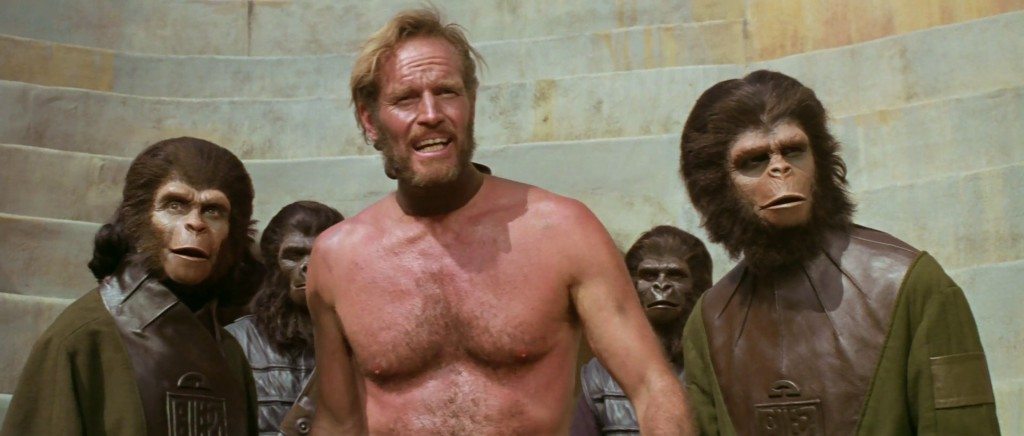It was based on a little known book entitled ‘Monkey Planet’ by French writer Pierre Boulle and Hollywood studios had been trying for years to make the picture, struggling with the ape make-up and a strong screenplay. They finally brought in Twilight Zone creator Rod Serling to hammer out the script while make-up artist John Chambers solved the issues of making actors apes.
Director Franklin J. Shaffner would direct the film, which would star Charlton Heston as Taylor, an astronaut marooned on an unknown planet when his craft crashes. He and his shipmates travel inward across a hostile desert to an open corn field and find a group of mute, virtually benign humans eating the raw corn. A growl is heard, and the humans flee, the astronauts with them. Into a clearing they come and for the first time Heston’s character Taylor sees what they are running from: apes on horseback. Further they have weapons, are organized and can speak. Somehow man has become the animal, the hunted on this upside down planet. Taken into the ape city after being shot in the throat he initially cannot speak, but Dr. Zira (Kim Hunter) senses intelligence in his eyes, and even kindness. His shipmates meet terrible fates, one of them killed in the hunt, the other lobotomized after his injuries in the hunt. As his wounds heal Taylor befriends Zira, making clear he can write and thereby communicate and eventually he speaks.
But where is he? He knows the year having seen it i the ship, 3955 AD, but has no idea where he is in the universe.
Celebrated as a great piece of science fiction — and it is — Planet of the Apes (1968) was critically hailed as one of the year’s best films, made a ton of money, inspired four sequels, two remakes and endless quotes. Serling had the genius to make the ape society very much like America in the sixties, with the orangutans as the government and authority, the gorillas as the army and military, and the chimpanzees as the pacifists and scientists. Man is the hunted, the hated, and for many reasons that become apparent as the film unfolds, hurtling towards one of the most unforgettable images in the history of the cinema.
Having never encountered a human who could speak, Cornelius (Roddy MacDowell) and Dr. Zira (Kim Hunter) are fascinated with Taylor and become friends with him seeing that the government is not in the right in butchering the humans. Taylor is tried in a crazy kangaroo court in which he is guilty going in, and sentenced to death then dissection. Aided by his two simian friends he escapes, and heads down the coast, the sea bright blue and clean.
And then he sees it.
Armpit deep in the sand, is the Statue of Liberty, long forgotten, wasting away to the ravages of time. At that moment Taylor knows he is back on earth, that the reading in the ship of the year was correct, that he is in the future, though it is the future of earth. Sinking to his knees in despair he rages “God damn you all to hell” as the camera pulls back to show us what he, finally, has seen.
The film was a huge hit with audiences and critics, and the ending is one of the most famous stinger endings in film history.
What is remarkable is how the film is endured. Sure they are rebooting series with motion capture apes, and it is terrific, showing how it all began, but this first film has a special place in history.
The performances of the actors under the make up is uncanny, each showing their own personality, each creating a fully realized character. Dr. Zira, kind and compassionate to her new friend Taylor, fascinated by him, eventually even attracted to him. Kim Hunter was superb in the role, and would return for two of the sequels. Roddy MacDowell would become a series mainstay, missing the second film but returning for the final three, even portraying Caesar, the son of Cornelius and Zira, who will lead the revolt against the humans. The series does come full circle, but each progressive film was a little shabbier than the one before it, until finally, it had to end.
Under appreciated for many years was the strong performance of Charlton Heston as Taylor, trying to come to terms with a world upside down. Heston, best known for his work in epics such as The Ten Commandments (1956) and Ben Hur (1959), for which he won the Academy Award, is brilliant throughout the film, giving what is both an intelligent performance but also a great physical performance. And so many great lines such as “get your stinging paws off me you damned dirty ape”, his words the first time the apes hear him speak, leaving them paralyzed with fear.
All but Dr. Zauis (Maurice Evans) who knows of the past, worries for the future, and understands Taylor will find and despair his destiny.
The film was nominated for a measly three Academy Awards, and won a special Oscar for achievement in make-up. Looking back to 1968. it is incredible both Planet of the Apes (1968) and 2001: A Space Odyssey (1968) were overlooked as Best Picture nominees (and 2001 as winner) as Oliver! (1968) took Best Picture.
Wildly entertaining, but also a strong social commentary for the times, Planet of the Apes (1968) remains one of the most important films of its time. The Tim Burton remake in 2001 was dreadful with one exception, Tim Roth’s seething performance as the chimpanzee head of the military.
The reboot with Andy Serkis as Caesar has thus far been sublime, but nothing has ever topped that stinger of the ending of the first, God, I get shivers.

